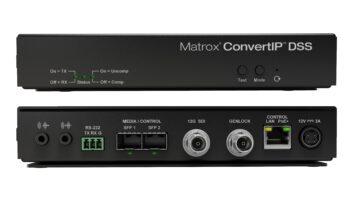
The HD DSLR revolution has taken an unexpected turn with the introduction of the first video camera based on a stills camera system, writes David Fox.
Panasonic announced a few new cameras at NAB, but the most notable was probably the first professional micro 4/3 HD video camcorder. Currently, Micro Four Thirds stills cameras with interchangeable lenses are available from Panasonic and Olympus (and will record video too, although at lower bit rates), but the new AG-AF100/AG-AF101 will give users a shallower depth of field than almost any broadcast camera (including those using 2/3-inch chips). It also benefits from being designed primarily for video rather than stills.
The camera is aimed at digital cinematography, and will be able to use any micro 4/3-inch lenses, filters or adapters (for access to other 35mm lenses). It will record AVCHD (up to 24Mbps 4:2:0) in 1080 60/50i, 30/25p and 24p (native) plus 720 60/50p, 30/25p and 24p (native), with variable frame rates and professional audio, on to SDHC and SDXC cards (two slots – allowing it to record up to 12 hours on two 64GB SDXC cards at best quality). It will be 60Hz/50Hz switchable for use in any country.
The micro 4/3 16:9 MOS imager will give a 2x crop compared to full frame 35mm stills cameras (so a 50mm 35mm stills lens is effectively 100mm – although the Panasonic’s chip size isn’t much smaller than a 35mm movie frame).
It will have built-in ND filtering and promises “dramatically reduced video aliasing” thanks to an optical low pass filter (aliasing is a common complaint with HD DSLRs). It will also have HD-SDI out (for uncompressed 4:2:2 recording), HDMI, USB 2.0, timecode recording, built-in stereo microphone, two XLR inputs with +48V Phantom Power, 48kHz/16-bit two-channel digital audio recording (LPCM/Dolby-AC3). It should be easier to hold than a DSLR-style camera, being about the size of Panasonic’s HPX200 camcorder (but a little taller).
It should be available by the end of 2010, with the price expected to be under $6,000. Of course, by then, Canon could have announced its own repackaging of a larger sensor HD DSLR in a video body, while Sony is promising its own 35mm digital line for early 2011 having shown a mock-up/prototype at NAB.







